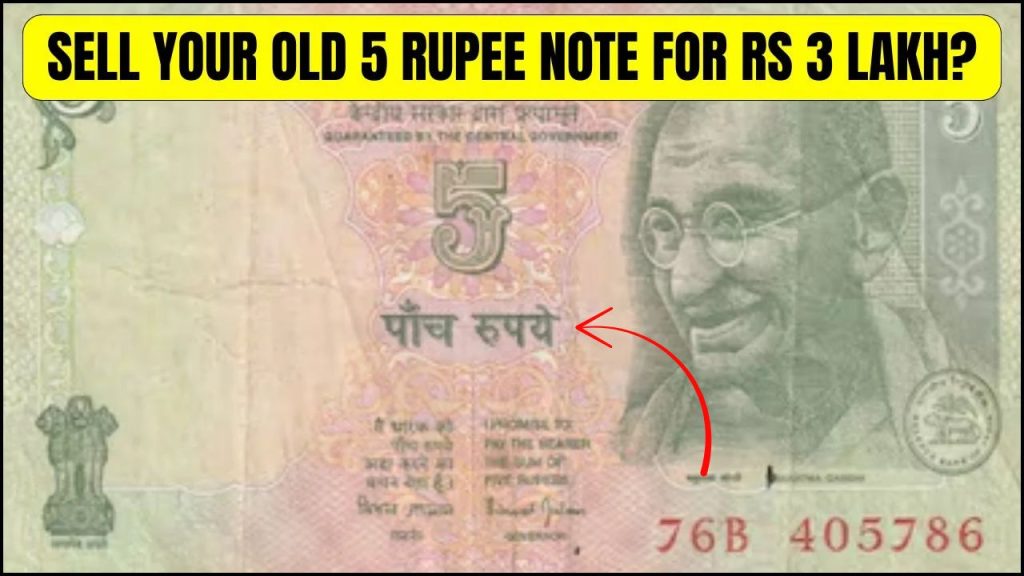
Have you ever wondered if that crumpled ₹5 note sitting in your old wallet could be worth more than its face value? You might be surprised to learn that certain old ₹5 currency notes are selling for astronomical amounts—up to ₹3 lakh—in the collector’s market. This isn’t a scam or wishful thinking; it’s a legitimate opportunity that has transformed ordinary people into unexpected beneficiaries of India’s thriving numismatic collecting scene.
The secret lies in understanding what makes these seemingly ordinary pieces of paper so valuable and how to capitalize on this hidden treasure. If you’ve got old currency lying around, it’s time to take a closer look—you might be sitting on a goldmine.
What Makes These ₹5 Notes So Special?
The extraordinary value of certain ₹5 notes isn’t just about age or rarity. It’s deeply rooted in cultural and spiritual significance that resonates with collectors worldwide. The most coveted feature is the presence of “786” in the serial number, which holds profound meaning in Islamic culture. This number represents the numerical value of “Bismillah-ir-Rahman-ir-Rahim” when calculated using traditional Abjad numerology.
But it’s not just about the number. These valuable notes typically feature Mahatma Gandhi’s portrait on the front and agricultural imagery—specifically a tractor with a seated farmer—on the reverse side. This combination represents India’s post-independence vision of progress and rural development, making them historically significant beyond their spiritual value.
| Value Driver | Significance | Market Impact | Collector Base |
|---|---|---|---|
| “786” Serial Number | Extremely High | 100-1000x multiplier | Islamic community, spiritual collectors |
| Gandhi Portrait | High | Historical premium | Political memorabilia enthusiasts |
| Agricultural Design | Medium | Cultural heritage value | Rural history collectors |
| Vintage Print Quality | High | Technical appeal | Printing history specialists |
| Limited Supply | Very High | Scarcity-driven demand | Investment-focused buyers |
How to Identify Valuable ₹5 Notes
Not every old ₹5 note will make you rich. You need to know exactly what to look for to determine if your note has collector value. The identification process requires careful examination of specific features that determine market worth.
The most critical element is the serial number configuration. Collectors pay premium prices for notes where “786” appears as consecutive digits. Numbers like “786,” “1786,” “5786,” or “78601” can dramatically increase your note’s value. The physical condition is equally important—notes in uncirculated or near-mint condition command the highest prices.
| Feature | Requirement | Value Impact | How to Check |
|---|---|---|---|
| Serial Number | Must contain “786” consecutively | Critical for premium pricing | Examine number sequence carefully |
| Front Design | Clear Gandhi portrait | Mandatory for authenticity | Check image clarity and completeness |
| Back Design | Tractor with farmer, visible tiller | Essential for full value | Inspect reverse side thoroughly |
| Physical Condition | No tears, folds, or stains | Determines final price tier | Assess overall wear and damage |
| Printing Era | Pre-2005 editions preferred | Historical premium | Look for issue year indicators |
| Paper Quality | Original government printing | Authenticity verification | Feel the texture and examine the print quality |
Understanding the Market Value
The potential earnings from selling rare ₹5 notes vary significantly based on the note’s characteristics and condition. Understanding this pricing structure helps set realistic expectations and develop an effective selling strategy.
Perfect specimens with all desired features in uncirculated condition can fetch between ₹2.5 lakh to ₹3 lakh. Notes with most features in near-mint condition typically sell for ₹1.5 lakh to ₹2.5 lakh. Even notes with partial features in good condition can command ₹50,000 to ₹1.5 lakh.
The real treasure lies in completely matched sets, multiple notes with sequential serial numbers or complementary features. These exceptional collections can reach ₹5 lakh or more, with some documented sales exceeding ₹12 lakh for sets of four related notes.
| Note Characteristics | Condition | Estimated Value | Market Demand |
|---|---|---|---|
| Perfect “786” + All Features | Uncirculated | ₹2,50,000 – ₹3,00,000 | Extremely High |
| “786” + Most Features | Near Mint | ₹1,50,000 – ₹2,50,000 | Very High |
| “786” + Some Features | Good | ₹50,000 – ₹1,50,000 | High |
| Partial Features Only | Fair | ₹5,000 – ₹50,000 | Moderate |
| Complete Matched Sets | Varies | ₹5,00,000+ | Exceptional |
Where and How to Sell Your Notes
The digital marketplace has revolutionized rare currency sales, providing unprecedented access to collectors worldwide. However, choosing the right platform and strategy is crucial for maximizing your returns.
Popular platforms include Quikr for local sales, eBay India for auction-style selling, and OLX for quick transactions. Facebook Marketplace leverages social networks, while specialized numismatic sites attract serious collectors. WhatsApp and Telegram groups offer access to niche communities of dedicated buyers.
Success depends heavily on presentation quality. Professional photography showing both sides clearly, close-up shots of serial numbers, and detailed descriptions highlighting unique features significantly impact sales success. Your listing should lead with the “786” serial number prominently, describe all visible features systematically, and include honest condition assessments.
Safety and Security Protocols
High-value transactions attract both legitimate collectors and potential fraudsters. Implementing robust safety protocols protects you from financial loss and personal security risks.
Use verified payment methods like bank transfers with immediate verification, cash transactions in bank premises, or platform-secured payment systems. Avoid checks, cash-on-delivery without verification, or unfamiliar wire transfers. Always meet buyers in public places or bank locations, never alone, and use platform messaging systems to minimize personal information sharing.
For shipping, use insured services with tracking numbers, take photographs of packaging, and require signature confirmation for delivery. Document everything throughout the transaction process to protect yourself from disputes or fraudulent claims.
Real Success Stories
The market has produced remarkable success stories that demonstrate the genuine potential of these sales. A Delhi resident recently sold a pristine “786” series note for ₹2.8 lakh after listing it on multiple platforms simultaneously. Another seller from Mumbai successfully auctioned a set of three related notes for ₹4.5 lakh by creating a compelling story about their discovery and historical significance.
These cases highlight that preparation, professional presentation, and patience significantly impact final sale prices. The key is understanding exactly what collectors value and presenting your notes accordingly.
Market Outlook and Timing
The rare currency collecting market continues evolving, influenced by economic conditions, cultural trends, and demographic shifts. Recent analysis indicates growing interest in Indian currency collectibles, particularly items with spiritual or cultural significance.
Social media success stories have increased public awareness, potentially affecting supply and demand dynamics. While this broader participation might moderate some prices over time, it also creates a more informed and active marketplace with greater opportunities for sellers who understand the market.
The current market conditions present an excellent opportunity for those fortunate enough to possess these rare notes. However, success demands patience, proper preparation, and adherence to best practices throughout the selling process.
Common Concerns
Q: Do all old ₹5 notes have value?
A: No, only notes with specific features like “786” in the serial number and proper design elements command premium prices.
Q: How long does it typically take to sell a valuable note?
A: Sales can take anywhere from a few days to several weeks, depending on pricing, presentation quality, and market demand.
Q: Is it safe to sell high-value currency notes online?
A: Yes, but only with proper safety protocols, including verified payments, insured shipping, and meeting buyers in secure public locations.
Q: Can damaged notes still have collector value?
A: Minor wear may be acceptable, but significant tears, stains, or damage substantially reduce value and marketability.

Mangesh garg is a passionate writer known for captivating stories that blend imagination and reality. Inspired by travel, history, and everyday moments, He crafts narratives that resonate deeply with readers.



